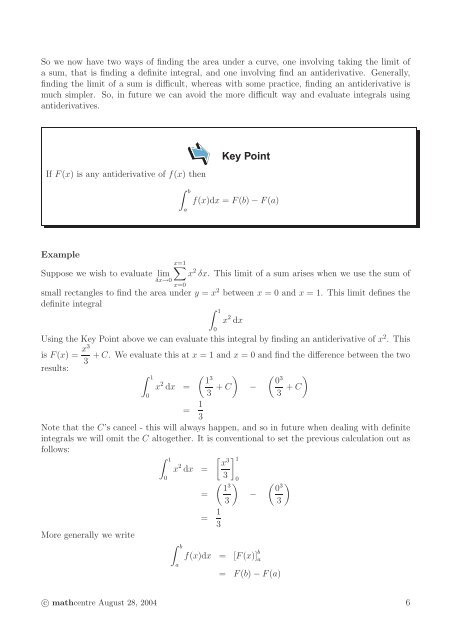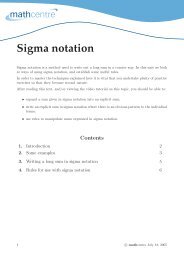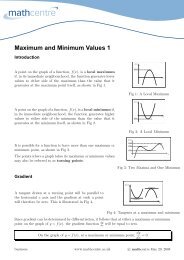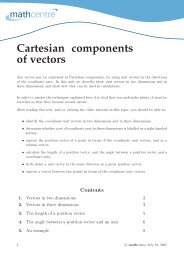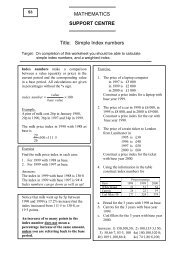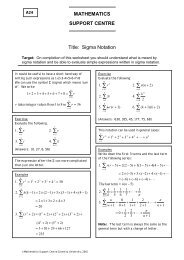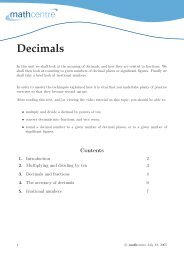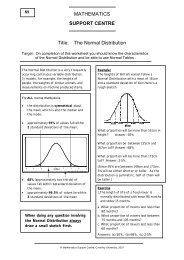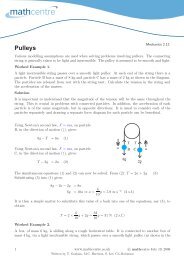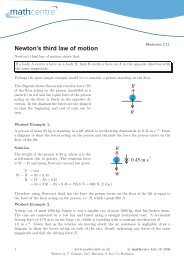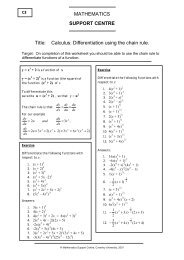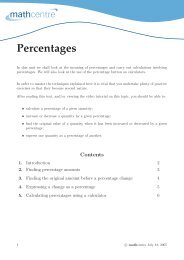indefinite integration as the reverse of differentiation
indefinite integration as the reverse of differentiation
indefinite integration as the reverse of differentiation
You also want an ePaper? Increase the reach of your titles
YUMPU automatically turns print PDFs into web optimized ePapers that Google loves.
So we now have two ways <strong>of</strong> finding <strong>the</strong> area under a curve, one involving taking <strong>the</strong> limit <strong>of</strong><br />
a sum, that is finding a definite integral, and one involving find an antiderivative. Generally,<br />
finding <strong>the</strong> limit <strong>of</strong> a sum is difficult, where<strong>as</strong> with some practice, finding an antiderivative is<br />
much simpler. So, in future we can avoid <strong>the</strong> more difficult way and evaluate integrals using<br />
antiderivatives.<br />
Key Point<br />
If F(x) is any antiderivative <strong>of</strong> f(x) <strong>the</strong>n<br />
∫ b<br />
a<br />
f(x)dx = F(b) − F(a)<br />
Example<br />
∑x=1<br />
Suppose we wish to evaluate lim x 2 δx. This limit <strong>of</strong> a sum arises when we use <strong>the</strong> sum <strong>of</strong><br />
δx→0<br />
x=0<br />
small rectangles to find <strong>the</strong> area under y = x 2 between x = 0 and x = 1. This limit defines <strong>the</strong><br />
definite integral<br />
∫ 1<br />
0<br />
x 2 dx<br />
Using <strong>the</strong> Key Point above we can evaluate this integral by finding an antiderivative <strong>of</strong> x 2 . This<br />
is F(x) = x3<br />
+ C. We evaluate this at x = 1 and x = 0 and find <strong>the</strong> difference between <strong>the</strong> two<br />
3<br />
results:<br />
∫ 1<br />
( ) ( )<br />
1<br />
x 2 3<br />
0<br />
3<br />
dx =<br />
3 + C −<br />
3 + C<br />
0<br />
= 1 3<br />
Note that <strong>the</strong> C’s cancel - this will always happen, and so in future when dealing with definite<br />
integrals we will omit <strong>the</strong> C altoge<strong>the</strong>r. It is conventional to set <strong>the</strong> previous calculation out <strong>as</strong><br />
follows:<br />
∫ 1<br />
[ ] x<br />
x 2 3 1<br />
dx =<br />
0 3<br />
0<br />
( ) ( )<br />
1<br />
3 0<br />
3<br />
= −<br />
3 3<br />
= 1 3<br />
More generally we write<br />
∫ b<br />
a<br />
f(x)dx = [F(x)] b a<br />
= F(b) − F(a)<br />
c○ mathcentre August 28, 2004 6


